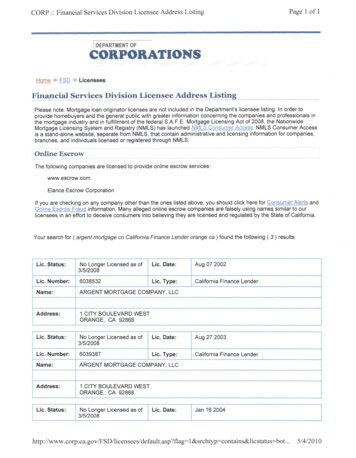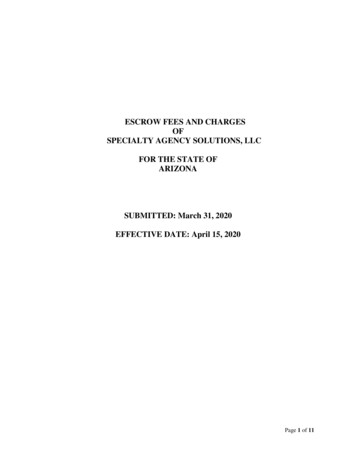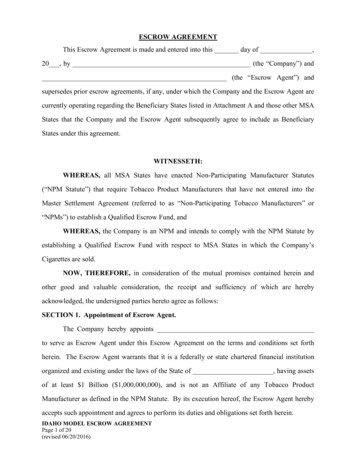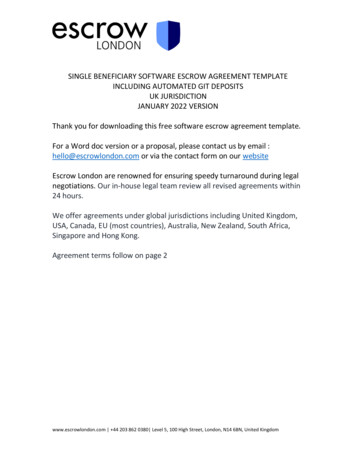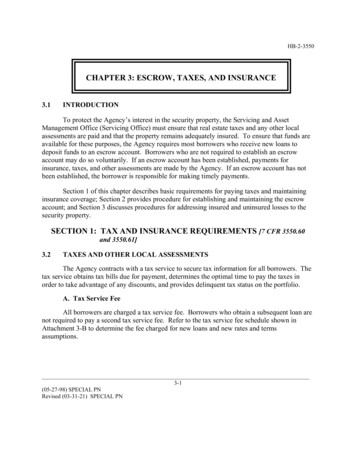
Transcription
HB-2-3550CHAPTER 3: ESCROW, TAXES, AND INSURANCE3.1INTRODUCTIONTo protect the Agency’s interest in the security property, the Servicing and AssetManagement Office (Servicing Office) must ensure that real estate taxes and any other localassessments are paid and that the property remains adequately insured. To ensure that funds areavailable for these purposes, the Agency requires most borrowers who receive new loans todeposit funds to an escrow account. Borrowers who are not required to establish an escrowaccount may do so voluntarily. If an escrow account has been established, payments forinsurance, taxes, and other assessments are made by the Agency. If an escrow account has notbeen established, the borrower is responsible for making timely payments.Section 1 of this chapter describes basic requirements for paying taxes and maintaininginsurance coverage; Section 2 provides procedure for establishing and maintaining the escrowaccount; and Section 3 discusses procedures for addressing insured and uninsured losses to thesecurity property.SECTION 1: TAX AND INSURANCE REQUIREMENTS [7 CFR 3550.60and 3550.61]3.2TAXES AND OTHER LOCAL ASSESSMENTSThe Agency contracts with a tax service to secure tax information for all borrowers. Thetax service obtains tax bills due for payment, determines the optimal time to pay the taxes inorder to take advantage of any discounts, and provides delinquent tax status on the portfolio.A. Tax Service FeeAll borrowers are charged a tax service fee. Borrowers who obtain a subsequent loan arenot required to pay a second tax service fee. Refer to the tax service fee schedule shown inAttachment 3-B to determine the fee charged for new loans and new rates and termsassumptions.3-1(05-27-98) SPECIAL PNRevised (03-31-21) SPECIAL PN.
HB-2-3550Paragraph 3.2 Taxes and Other Local AssessmentsB. Borrowers Failure to Pay TaxesBorrowers not on escrow are responsible for paying their real estate taxes each year andsubmitting proof of payment to the Servicing Office. When the Agency is notified that aborrower has not paid real estate taxes on the property or other local assessments, the ServicingOffice must notify the borrower that proof of payment must be submitted to the Servicing Officewithin 60 days. If the borrower fails to submit proof of payment, the Servicing Office taxes andany penalties and charge the cost as an advance to the borrower’s account. The Servicing Officewill not generally pay taxes and penalties in cases where there is another known lien holder, thesecurity property also includes a farm, or net recovery is not anticipated unless it is determined tobe in the best interest of the Agency. If the Agency advances funds to pay taxes or insurance, theborrower will be required to convert to escrow. When an escrow account is established, theadvance will be repaid over the remaining term of the loan minus ten years. If the loan has lessthan 10 years remaining, the fee will be spread over 2 years or the remaining term, whichever isless.C. Recapture Receivable AccountsDelinquent tax notices/pending tax sale notices from taxing authorities on recapture receivableaccounts should be forwarded to the Tax Unit at the Servicing Office for handling. The noticescan be faxed to (314)457-4535. Upon receipt of a notice of pending tax sale, the Servicing Officewill review the recapture receivable account to determine if it is in the best interest of theAgency to pay the taxes to avoid the tax sale and protect the Government’s interest in theproperty. If the taxes are paid the Servicing Office will demand payment from the borrower. Ifpayment is not made a foreclosure action will pursue.3.3INSURANCE REQUIREMENTSBorrowers are responsible for obtaining and continuously maintaining insurance on thesecurity property until the loan is paid in full. Evidence of insurance coverage for the first yearof a loan must be provided at closing. In subsequent years, borrowers not on escrow are requiredInsurance on Acquired PropertyInsurance will not be carried on properties that the Agency has acquired. After a foreclosuresale has been held or after a deed in lieu of foreclosure has been filed for record, insurance will not becanceled but will not be renewed. If the property becomes uninsured between the time when theborrower defaults on the loan and the time when the Agency obtains title, the Agency will force placeinsurance to protect its interests.to pay insurance premiums and send proof of premium payment to the Servicing Officeannually. For borrowers on escrow, the Servicing Office makes the premium payments.3-2
Paragraph 3.3 Insurance RequirementsHB-2-3550A. Policy RequirementsBorrowers must purchase policies from approved insurance companies. Attachment 3-Aprovides the minimum standards insurance policies must meet. When a loan is made, Field Staffare responsible for reviewing the applicant’s proposed insurance coverage to determine whetherit is adequate. The Servicing Office also reviews these policies for adequacy when closingdocuments are forwarded from the Field Office and approves any subsequent changes toborrower insurance policies. Borrowers may need to obtain three types of insurance.1. Hazard InsuranceMost borrowers are required to maintain hazard insurance to protect the propertyagainst fire, wind, and weather-related damage. These policies may also be called “Fireand Extended Coverage,” “Homeowner’s,” “All Physical Loss,” or “Broad Form”policies.Any borrower with a secured indebtedness in excess of 15,000 at the time of loanapproval must furnish and continually maintain hazard insurance on the security property,with companies, in amounts, and on terms and conditions acceptable to RHS and includea “loss payable clause” payable to RHS to protect the Government’s interest.”.For borrowers initially required to maintain hazard insurance, the Servicing Office mayforce place coverage for the benefit of the Agency and charge the cost to the borrower’s account.2. Flood InsuranceFlood insurance is required for all properties located in a Special FloodHazard Area (SFHA), as identified by the Federal Emergency ManagementAgency (FEMA) and described in RD Instruction 426.2, except for loans andgrants with an original principal balance of 5,000 or less.FEMA’s Standard Flood Hazard Determination is used to document whether aproperty is in a SFHA and whether flood insurance is available under FEMA’s NationalFlood Insurance Program. If the property is in a SFHA, the borrower should be notifiedusing Form RD 3550-6, Notice of Special Flood Hazards, Flood Insurance PurchaseRequirements, and Availability of Federal Disaster Relief Assistance. The borrower mustsign and return the form. If the borrower in a SFHA cannot secure flood insurancethrough FEMA’s National Flood Insurance Program, the property is not eligible forFederal financial assistance.3-3(05-27-98) SPECIAL PN;Revised (03-31-21) SPECIAL PN
HB-2-3550Paragraph 3.3 Insurance RequirementsDwellings located in the 100 year flood plain have additional requirements that must be met in regards toelevation levels, public utilities or on-site water supply and waste disposal systems requirements, andcompletion of the eight step decision making process for alternative consideration. (see RD Instruction1970-F, section 1970.256 for further requirements).3. Builder’s Risk PoliciesThe borrower may elect to obtain a builder’s risk policy that meets the Agency’srequirements while the dwelling is under construction. An acceptable policy either: (1)names the borrower as the insured; or (2) contains a builder’s risk endorsement for apolicy issued to the borrower. A policy issued only to a contractor is not an acceptablesubstitute for the property insurance a borrower is required to provide.The Servicing Office should ensure that the builder’s risk policy automaticallyconverts to full coverage when the dwelling is completed. Otherwise, acceptableinsurance must be obtained to coincide with the expiration of the builder’s risk provisionsof the policy.B. Acceptable Evidence of InsuranceFor loans secured by a first lien, the borrower must provide the original policy or declarationpage. For loans secured by other than a first lien, a copy of the policy or declaration page, orother evidence of insurance, is acceptable. At loan closing the applicant may submit a writtenbinder in lieu of the policy or declaration page, as long as the policy will be submitted to theServicing Office within 60 days of closing.C. Force Placed InsuranceForce placed insurance is insurance coverage the Agency obtains for a securityproperty when the borrower is unable or unwilling to provide adequate and acceptableinsurance coverage. If the Agency force places insurance, the Servicing Office will makean advance to pay for the coverage and will inform the borrower of the new insurance.Borrowers must submit acceptable evidence of other insurance before the force placedinsurance can be removed.3.4SERVICING ACTIONS RELATED TO INSURANCEA. Reviewing Policies for AcceptabilityAfter loan closing, Field Staff will send the borrower’s policy to the Servicing Office alongwith other closing documents. The Servicing Office should review the policy to ensure that itmeets the Agency’s requirements as described in Attachment 3-A. If the policy is acceptable, theServicing Office should image the policy and enter the policy information into LoanServ. If theborrower’s policy is not acceptable, the Servicing Office should notify the borrower, explain whythe policy is unacceptable, and request that the borrower submit an acceptable policy.3-4
Paragraph 3.4 Servicing Actions Related to InsuranceHB-2-3550B. Annual PaymentsFor borrowers on escrow, the Servicing Office will pay annual insurance premiums fromthe escrow account. The borrower’s insurance company must submit a renewal notice to theServicing Office indicating the amount of the next year’s insurance premium. SO must pay therequired premium before the expiration date in order to prevent any lapse in insurance.Borrowers not on escrow are responsible for paying insurance premiums and sending theServicing Office evidence of payment and the declaration page. If the Servicing Office does notreceive evidence of insurance coverage they will advise the borrower within 10 days after thepolicy’s expiration date that the Agency will force place insurance if they fail to provide thenecessary documentation within 60 days after the date of notification (45 days for floodinsurance). Cost of the insurance will be charged to the borrower’s account and the borrowerwill be required to escrow for taxes and insurance.C. Reviewing Changes in Insurance CoverageBorrowers who wish to change insurance policies must submit a replacement policy andevidence of payment to the Servicing Office at least 60 days before the current policy expires. Ifthe replacement policy is received with less than 60 days notice and the Servicing Office hasalready disbursed a payment for the existing policy from the escrow account, the borrower isresponsible for obtaining reimbursement of the paid premium.The Servicing Office must review the replacement policy to ensure that it meets theAgency’s requirements outlined in Attachment 3-A and may contact the applicable State Officeto verify whether the insurance carrier is authorized to conduct business in the State. If theborrower’s policy is not acceptable, the Servicing Office should inform the borrower of thereason (for example, there is not an adequate amount of coverage, it is not in the correct name, orthe premium has not been paid) and request that the borrower submit an acceptable policy. Ifnecessary, the Servicing Office will force place insurance.D. Cancellation of InsuranceFor borrowers on escrow, the borrower’s insurance company must send to the ServicingOffice any notice of cancellation or nonrenewal. Within 3 days of receiving the notification, theServicing Office must notify the borrower of the need to get new insurance coverage before theexisting policy expires.3-5(05-27-98) SPECIAL PNRevised (03-31-21) SPECIAL PN
HB-2-3550Paragraph 3.4 Servicing Actions Related to InsuranceThe borrower must send an invoice to the Servicing Office for payment and shouldinclude a copy of the policy, if it is available. If the borrower does not submit a new hazard orflood policy and invoice within 10 days of the old policy’s cancellation the Servicing Office willinitiate action to force place insurance coverage on the property. If the borrower does not submita new hazard or flood insurance policy and invoice within 70 days of the previous policy’sexpiration date (45 days for flood insurance), the Servicing Office will force place insurance.If a borrower not on escrow receives a notice of cancellation or nonrenewal, the borrowermust secure new insurance coverage before the current policy expires. The borrower mustsubmit proof of insurance coverage and evidence of payment to the Servicing Office before thepolicy expires. Borrowers who cannot secure new insurance coverage should contact SOimmediately. the Servicing Office will then force place insurance for the security property.E. Vacant or Leased UnitsIf the Agency becomes aware that a security property is vacant or leased, the ServicingOffice should review the policy to determine if it permits such conditions. If it does not, theServicing Office should immediately notify the insurance carrier in writing. If the insurancecarrier requires an additional premium because of the vacancy, tenant occupancy, or otherincreased hazard, the Servicing Office will pay the additional premium from the borrower’sescrow account, if one exists. Borrowers not on escrow are responsible for paying the increasedpremiums. If the borrower is unable to pay the increased premium, the Agency may pay theadditional premium and charge the cost to the borrower’s account.F. Transfer of Property1. AssumptionsIn a transfer with assumption, insurance will be required in the same amount andaccording to the same provisions as for an initial loan of the same type. The new ownermay obtain a new policy or have the current insurance company issue an endorsement tothe current insurance policy, changing the name of the insured to that of the new owner.2. Payment in FullWhen a borrower pays off the Agency’s debt in full, the Agency releases its insuranceinterest in the security property. the Servicing Office should notify the insurance agencyof record to remove the Agency’s interests from the mortgagee or loss payable clause.3-6
Paragraph 3.4 Servicing Actions Related to InsuranceHB-2-35503. Transfers Without Satisfying Agency DebtIf the Agency becomes aware that the borrower has transferred title to the propertywithout satisfying the Agency’s debt, the Servicing Office should immediately notify thenew owner that the mortgage requires the owner to provide and maintain adequate,acceptable insurance with the Agency listed as the mortgagee. In addition, the newowner should be informed that evidence of coverage and payment must be received bythe Servicing Office within 30 days. If the evidence is not received in that time frame,the Servicing Office will force place insurance. The Agency will notify the borrower andnew owner that acceptance of the new policy or endorsement will not constitute consentby the Government to the transfer.3-7(05-27-98) SPECIAL PNRevised (03-31-21) SPECIAL PN
HB-2-3550(This page was intentionally left blank)3-8
HB-2-3550SECTION 2: ESCROW REQUIREMENTS3.5OVERVIEW OF ESCROW REQUIREMENTSA. Requirement to escrowThe Agency requires most borrowerswho receive new loans to escrow funds for taxesand insurance.Borrowers are exempt from escrowrequirements if they:Escrow StatutesThe Agency administers escrowaccounts in accordance with the Real EstateSettlement and Procedures Act of 1974(RESPA) and section 501(e) of the Housing Actof 1949. Are current on an annual paymentplan; Have a leveraged loan and the escrow is maintained by the primary lendinginstitution; Have received only a Section 504 grant; Have Section 504 loans with a total outstanding balance of 15,000 or less, and theAgency determines there is no risk to the Government’s security interest in theproperty; Have a Section 504 loan and the Agency does not hold a mortgage interest in theproperty; or Assume a current loan (not past due) on same rates and terms; or Have security property which includes a farm and the property is not subdividedbetween farm and non-farm tract. In these cases, the Agency may still elect to requireescrow where the housing represents the majority of the value of the security propertyor it is in the Agency’s best interest to require escrow.3-9(05-27-98) SPECIAL PNRevised (03-31-21) SPECIAL PN
HB-2-3550Paragraph 3.5 Overview of Escrow RequirementsExisting borrowers who do not have escrow accounts may voluntarily establish an escrowaccount. Existing borrowers who pay on a monthly basis and annual-pay borrowers withmonthly income must establish escrow accounts if: The borrower obtains a subsequent loan; The borrower requests a Delinquency Workout Agreement; The borrower’s loan is reamortized as a servicing action; or Because of borrower failure to pay, the Agency must advance funds to pay forinsurance, taxes, or other local assessments. The advance will be repaid over theremaining term of the loan minus ten years. If the loan has less than 10 yearsremaining, the fee will be spread over 2 years or the remaining term, whichever isless.B. Sources of Escrow FundingAt the time the escrow account is established an initial deposit to the account is required.Once the escrow account is established, a portion of the borrower’s monthly payment continuesto fund the escrow account. Exhibit 3-1 illustrates the calculation of the initial deposit andmonthly escrow payment.3.6ESTABLISHING ESCROW ACCOUNTS FOR NEW LOANSA. Field Office ResponsibilitiesNo later than loan closing, the borrower must provide proof of insurance coverage. FieldStaff will enter the borrower’s estimated taxes and insurance premiums into UniFi, whichautomatically calculates the initial deposit and the monthly payment. The ClosingAgent/Attorney collects escrow funds at closing and, in most cases, provides the funds to the theServicing Office along with the closing documents. If real estate taxes are due within 60 days ofthe date of closing, the Closing Agent/Attorney will pay the real estate taxes and submit theremaining amount to the the Servicing Office.Exhibit 3-2 lists the closing documents related to taxes and insurance and provides processing instructionsfor each.3-10
HB-2-3550Paragraph 3.6 Establishing Escrow Accounts for New LoansExhibit 3-1Escrow Account FundingThe initial escrow balance and the escrow payment amount are calculated in accordance with RESPA. UniFiprepares Form RD 3550-9, Initial Escrow Account Disclosure Statement described in Paragraph 3.6 B.2. Thefollowing example is intended to show how escrow accounts are funded each year.Assumptions:(1) The loan closing occurs on February 12, 1996 with the first payment due April 1, 1996.(2) Taxes of 214.88 are paid in July and December.(3) Hazard insurance of 319.00 is paid in January.(4) The Agency requires a cushion equal to 2 months of payments.Monthly Payment Calculation: 214.88 214.88 319.00 748.76 62.39Total anticipated escrow disbursements divided by 12 equalsper month escrow paymentMonthPayments to EscrowLoan berDecemberJanuaryFebruaryMarch 249.64 62.39 62.39 62.39 62.39 62.39 62.39 62.39 62.39 62.39 62.39 62.39 62.39Disbursements 0.00 0.00 0.00 0.00 214.88 0.00 0.00 0.00 0.00 214.88 319.00 0.00 0.00Balance 249.64 312.03 374.42 436.81 284.32 346.71 409.10 471.49 533.88 381.39 124.78 187.17 249.56The borrower will be required to pay 62.39 per month and will also be required to fund the escrow account atclosing in the amount of 249.64. Part of the tax payment component of the initial escrow deposit will becontributed by the seller for the period from January 1st to the closing on February 12th.According to RESPA, the lending institution at some time during the year must achieve an escrow balance thatserves as a cushion but does not exceed 2 monthly escrow payments. In this example, the balance equal to 2monthly payments ( 124.78), occurs in January after the payment for hazard insurance.the Servicing Office is required to perform an escrow analysis within 12 months of the first payment and everyyear thereafter. The actual running escrow balance from the prior year will become the basis for projecting thenecessary escrow payment for the next year. The low point achieved will be compared to the projected minimum of 124.78. If the low point is below 124.78, the loan will be deemed to have a shortage. If the low point is greaterthan 50.00, the loan will have a surplus, which will be refunded to the borrower, if the surplus is less than 50.00, itwill be or credited to the next year’s escrow.3-11(05-27-98) SPECIAL PNRevised (03-31-21) SPECIAL PN
HB-2-3550Paragraph 3.6 Establishing Escrow Accounts for New LoansExhibit 3-2Closing Documents Related to Tax and Insurance Form RD 3550-19, Initial Escrow Account Disclosure Statement, shows theamount of the initial escrow deposit. Closing Disclosure. The Servicing Office must verify that the real estatetaxes have been properly pro rated between the buyer and seller by reviewingthe Closing Disclosure. Tax information. The Servicing Office must enter into LoanServ theinformation on taxing authorities, parcel number, due dates, and taxinformation from Form RD 3550-15 Tax Information. Title insurance policy. The Servicing Office must verify that the legaldescription of the property is consistent with the closing documents. Insurance documentation. The Servicing Office must review the insurancedocumentation (either a policy, declaration page, or binder) and enter intoLoanServ information such as the cost, coverage period, coverage amount,company, and beneficiaries.B. The Servicing Office ResponsibilitiesAfter reviewing the information sent by the Field Staff, the Servicing Office deposits theescrow funds and verifies the information on Form RD 3550-15.1. Notification to Tax ServiceWithin 30 days of establishing the escrow account, the Servicing Office should sendthe completed tax worksheet to the tax service, along with the loan identification number,the parcel number, a legal description of the borrower’s property, and the tax service fee.The tax service will set up the borrower’s information in its system and generate a uniquetax service contract number. The tax service will then send the borrower’s contractnumber to the Servicing Office. This number will be entered into LoanServ to helpidentify the borrower’s account.2. Initial Escrow Account Disclosure StatementThe field office is responsible for completing the Form RD 3550-9 “Initial EscrowAccount Disclosure Statement”. The statement will be initialed by the borrower at closing andthe borrower will be provided a copy of the statement. The signed statement will be forwarded tothe Servicing Office with the closing documents.3-12
Paragraph 3.6 Establishing Escrow Accounts for New LoansHB-2-3550The initial disclosure statement should include the amount of the borrower’s monthlymortgage payment and the portion of the payment going into the escrow account. Itshould itemize the estimated taxes and insurance premiums to be paid from the accountduring the upcoming year. It also should show the cushion and a trial running balance forthe account. (A trial running balance is a projected escrow balance for each monthduring the computation year.)3. Construction LoansWhen a borrower receives a construction loan, an escrow account is not establisheduntil after construction is complete. In addition, since loan payments are deferred duringthe construction period, monthly escrow payments are not paid. Two options areprovided to loan applicants to handle taxes and insurance. One option is to include in theloan amount, subject to loan underwriting requirements, taxes which come due duringconstruction and the amount to fund the initial escrow deposit. The other option is for theborrower to use personal funds to pay taxes when due and for the initial escrow deposit tobe paid by the borrower in a lump sum when the construction loan is converted to apermanent loan. If the borrower does not pay tax bills or insurance bills which becomedue during construction or there are insufficient funds to establish the escrow accountwhen the loan is converted, the Field Office will cue the Servicing Office and provide theestimated amount of the shortage, and the facts in the case. The Servicing Office willgenerally increase the monthly payment scheduled for the remainder of the escrow cycleto compensate for the shortage. The Servicing Office may also elect to charge theborrower’s account for any shortage and reamortize the loan.Borrowers must be counseled that they are ultimately responsible for payment ofinsurance premiums and while the costs may be included in the loan, the borrower isresponsible to cover any shortage which may occur.If construction is completed as planned, the course of construction (Builder’s Risk)policy should remain in effect without an additional premium due during construction.However, if a second premium is due during construction, the borrower is responsible forthis payment. Within 30 days of the anticipated construction completion date, theborrower will provide the Field Office with a copy of the binder for a hazard insurancepolicy and a receipt showing it has been paid in full for one year, OR a request for adraw from the construction loan to pay one year’s hazard insurance premium in full, asapplicable.3-13(05-27-98) SPECIAL PNRevised (03-31-21) SPECIAL PN
HB-2-3550Paragraph 3.7 Establishing Escrow Accounts for Existing Loans3.7ESTABLISHING ESCROW ACCOUNTS FOR EXISTING LOANSA. Determining the Escrow AmountTo establish an escrow account for a borrower with an existing loan, the Servicing Office mustgather the information discussed in the following paragraphs.1. Insurance InformationCurrent information on insurance coverage should be available in the Servicing Officerecords. If current information is not available, the Servicing Office should contact theborrower at least 30 days prior to establishing an escrow account, notifying them that they mustprovide proof of insurance coverage.When the policy information is received, the Servicing Office must review it to ensure thatit meets the Agency’s requirements, as described in Attachment 3-A, and enter information aboutthe insurance into LoanServ. If the borrower cannot or will not obtain insurance coverage, theServicing Office will force place insurance.2. Tax InformationThe Servicing Office will confirm with the borrower the taxing authorities to which taxesare due, the amount of taxes paid by the borrower last year, and the due dates. the ServicingOffice will verify this information, enter it into LoanServ, and establish an escrow account.Once the necessary information is entered into LoanServ, the escrow analysis unit willcalculate the escrow amount (both the initial deposit and the monthly amount). The ServicingOffice should change the tax service code in LoanServ to reflect that the borrower is now onescrow and within 30 days of setting up the escrow account, inform the tax service that theborrower has been converted to escrow. The tax service will then be changed to escrow.B. Obtain Funds for the Escrow AccountOnce the escrow account is set up, the Servicing Office must deposit the specified escrowfunds into the borrower’s escrow account. If the escrow account contains insufficient funds topay the insurance and taxes when due, the Servicing Office will advance an amount equal to thedifference between the amount due and the escrow balance. At the time of the annual escrowanalysis, any negative balances or shortage will be spread over 12 months and collected with theescrow portion of the borrower’s mortgage payments.C. Notify the BorrowerOnce the escrow account has been established, the Servicing Office must send writtennotification to the borrower which includes an explanation of the establishment and function ofthe escrow account and Form RD 3550-9. See Paragraph 3.6 B.2 for a description of thisdocument. The disclosure statement must be sent within 45 days after creating the escrowaccount.3-14
3.8ESCROW PAYMENTSHB-2-3550Termination of Escrow PaymentsEscrow disbursements will stopThe Servicing Office will disburse fundsimmediatelyupon debt settlement or release ofas necessary to pay tax and insurance bills, assecurity.well as other appropriate expenses. TheServicing Office will be responsible for ensuringthat all escrow payments are made at the optimal time to take advantage of any discounts andavoid penalties.3.9ANNUAL ESCROW ANALYSISRESPA requires the Servicing Office to conduct an annual escrow account analysis foreach borrower that has an escrow account. RESPA also requires the Servicing Office to provideborrowers with an Annual Escrow Disclosure Statement that shows the account history andprojects activity for the coming year. A borrower’s monthly payment to the escrow account mayincrease or decrease as a result of the analysis. The Servicing Office must mail the disclosurestatement at least 30 days prior to the new payment effective date.A. SurplusesSurpluses arise when the account balance does not reach the expected low point of twomonthly escrow payments during the year. When a surplus for an escrow account is greater thanor equal to 50 and the borrower is current on the loan, the Servicing Office will generate acheck and return the surplus to the borrower with the Annual Escrow Disclosure Statement.B. ShortagesShortages arise when the escrow balance is less than the expected low point during
insurance, taxes, and other assessments are made by the Agency. If an escrow account has not been established, the borrower is responsible for making timel y payments. Section 1 of this chapter describes basic requirements for paying taxes and maintaining insurance coverage; Section 2 provides procedure for establishing and maintaining the escrow
